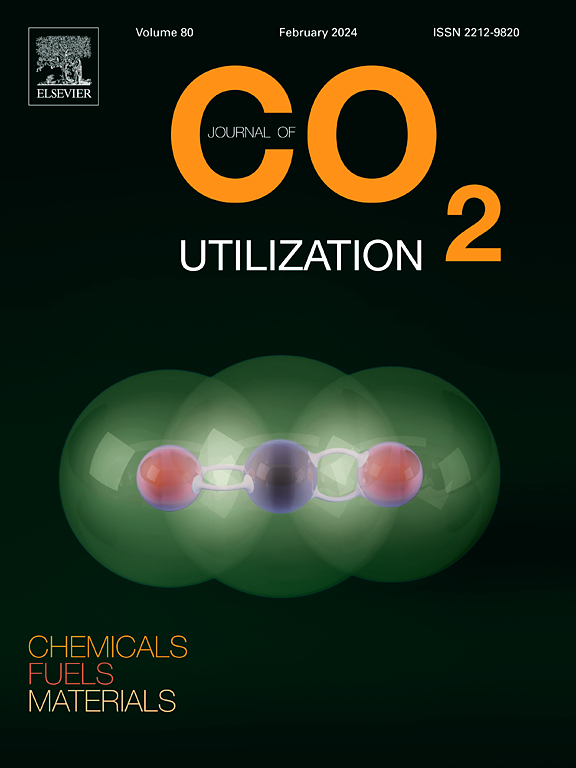混合Ni-Co亚化学计量尖晶石作为甲烷干重整的催化前驱体
IF 8.4
2区 工程技术
Q1 CHEMISTRY, MULTIDISCIPLINARY
引用次数: 0
摘要
采用共沉淀法合成了8颗(Ni+Co)/Al摩尔比在0.05 ~ 0.50之间的Ni-Co混合尖晶石,作为甲烷反应干重整双金属Ni-Co催化剂的前驱体。通过BET测量、x射线衍射、拉曼光谱、XPS光谱、STEM/HAADF、STEM/EDS元素图、H2程序升温还原、CH4程序升温表面反应、CO2程序升温解吸、热重分析和TEM对煅烧和还原样品进行了表征,并研究了它们在650℃、80 L g−1 h−1条件下的甲烷干重整催化活性。所有(Ni+Co)/Al摩尔比低于0.25的前驱体均表现出高尖晶石形成程度,且不存在分离的氧化物。另一方面,所有还原催化剂都呈现出相似的结构,晶粒尺寸在20 ~ 30 nm之间,由均匀的Ni-Co合金组成,没有孤立的金属。以(Ni+Co)/Al摩尔比为0.15的尖晶石前驱体为基础的催化剂对H2的生成最具活性和选择性,反应24 h后CH4转化率为93 %,生成H2/ Co摩尔比为1.1的合成气。尽管形成了大量的碳质沉积物,但该最佳样品仍然能够有效地运行200 h。本文章由计算机程序翻译,如有差异,请以英文原文为准。
Mixed Ni-Co sub-stoichiometric spinels as catalytic precursors for dry reforming of methane
Eight mixed Ni-Co spinels with (Ni+Co)/Al molar ratios between 0.05 and 0.50 were synthesised by co-precipitation to serve as precursors for bimetallic Ni-Co catalysts for the dry reforming of methane reaction. Both calcined and reduced samples were examined by BET measurements, X-Ray diffraction, Raman spectroscopy, XPS spectroscopy, STEM/HAADF, STEM/EDS elemental mapping, temperature-programmed reduction with H2, temperature-programmed surface reaction with CH4, temperature-programmed desorption of CO2, thermogravimetric analysis and TEM, and their catalytic activity was studied for the dry reforming of methane at 650 °C at 80 L g−1 h−1. All the precursors synthesised with (Ni+Co)/Al molar ratios below 0.25 presented a high degree of spinel formation without the presence of segregated oxides. On the other hand, all the reduced catalysts presented a comparable structure, with crystallites of sizes between 20 and 30 nm composed of a homogeneous Ni-Co alloy, with the absence of isolated metals. The catalyst based on the spinelic precursor with a (Ni+Co)/Al molar ratio of 0.15 resulted the most active and selective towards H2 formation, achieving CH4 conversion values of 93 % after 24 h of time on stream and yielding a syngas with a H2/CO molar ratio of 1.1. Despite significant formation of carbonaceous deposits, this optimum sample was still able to operate efficiently for 200 h.
求助全文
通过发布文献求助,成功后即可免费获取论文全文。
去求助
来源期刊

Journal of CO2 Utilization
CHEMISTRY, MULTIDISCIPLINARY-ENGINEERING, CHEMICAL
CiteScore
13.90
自引率
10.40%
发文量
406
审稿时长
2.8 months
期刊介绍:
The Journal of CO2 Utilization offers a single, multi-disciplinary, scholarly platform for the exchange of novel research in the field of CO2 re-use for scientists and engineers in chemicals, fuels and materials.
The emphasis is on the dissemination of leading-edge research from basic science to the development of new processes, technologies and applications.
The Journal of CO2 Utilization publishes original peer-reviewed research papers, reviews, and short communications, including experimental and theoretical work, and analytical models and simulations.
 求助内容:
求助内容: 应助结果提醒方式:
应助结果提醒方式:


